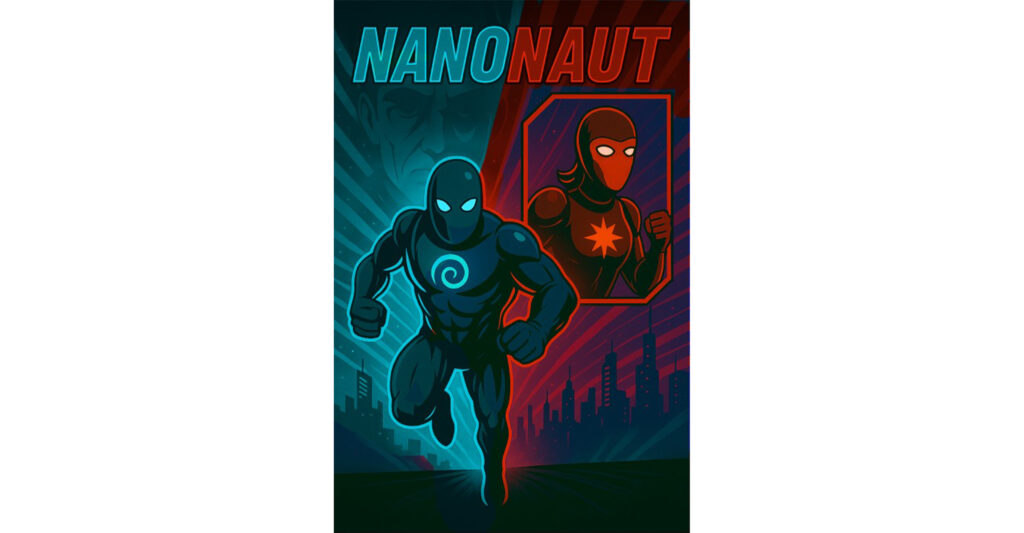In a lively conversation with Wayne Stewart, the author of Nanonaut, it’s clear that his journey to writing this genre-bending sci-fi novel was as organic as it was unexpected. Speaking with a warm, reflective tone, Stewart shared how a chance encounter with lackluster online storytelling sparked his creative fire. “I came across a webpage that offered free books to read, but it was more like a letter than a story,” he recalled with a chuckle. “I thought, ‘That’s not how you tell a story.’ So, I started writing one in a proper storybook format, posted it, and they liked it. That’s what got me started.”
What began as a casual foray into storytelling evolved into Nanonaut, a novel that blends science fiction, coming-of-age drama, humor, and a touch of erotica into a vivid exploration of transformation. The story follows Jeremy Dodd, a teenage geek who accidentally becomes a superhuman vessel for his father’s experimental nanobots. These microscopic marvels grant him extraordinary abilities; perfect vision, rapid healing, enhanced strength, and even the ability to turn invisible while introducing an AI-like voice in his head that’s as much a partner as it is a passenger. Stewart’s inspiration for the novel came from a real-world fascination with nanotechnology. “I’d read a science article about nanobots they were trying to create,” he said. “I thought that would be an interesting story to tell.”
From Comic Book Dreams to a Full-Fledged Novel
Stewart originally envisioned Nanonaut as a comic book concept, centered on the idea of science transforming a human into something superhuman, grounded in natural possibilities. “If it can occur in nature, it could probably occur in a human,” he explained, citing examples like chameleons or creatures that climb walls. “If you can develop these abilities in a human, they’d be superhuman.” But what started as a superhero sketch grew into a full-length novel with surprising depth. “At one point, the book starts writing itself,” Stewart admitted. “You become enthralled, wondering what’s going to happen next. It’s like tapping into a sixth sense.”
This organic writing process allowed Stewart to write a narrative that’s as emotionally resonant as it is action-packed. Jeremy’s journey from a bullied, awkward teen to a confident hero mirrors the universal struggle of adolescence, amplified by the sci-fi twist of nanobot-enhanced abilities. Stewart infused the character with a slice of his own experience, estimating that “a good, solid 10%” of Jeremy reflects his own life as a “skinny runt” who faced bullying. “A good story has some really positive truth in it,” he said. “You always add some of your experience in there.”
A Symbiotic Dance of Technology and Humanity
One of the most striking elements of Nanonaut is the personality of the nanobots themselves, which Stewart dubs the “Nanonaut”, a nod to their role as tiny astronauts navigating Jeremy’s body. “Jeremy is just the ship for this Nanonaut,” he explained. By giving the nanobots intelligence and a voice, Stewart explores the interplay between technology and humanity, a theme that feels eerily prescient despite the book being written in 2016, before AI became a cultural juggernaut. “If you gave these nanobots intelligence, you could communicate with them and see what their agenda is,” he mused. The Nanonaut’s role raises questions about control, autonomy, and identity, especially as it enhances Jeremy’s body while subtly influencing his decisions. “It’s like a car warning you when you’re too close to something,” Stewart said. “It’s concerned about its own survivability.”
The novel doesn’t shy away from raw, human elements either, awkwardness, insecurity, and even sexuality are included into Jeremy’s transformation. Stewart made a conscious choice to lean into this honesty, aiming for a “pure dialect” free of stigma. “If there were no moral implications, it releases some limitations,” he said, explaining how he wanted the characters’ interactions to feel authentic, unburdened by societal taboos. This approach makes Nanonaut refreshingly candid, particularly in its portrayal of male vulnerability, a rarity in fiction. “I wanted to imply that the perception of things can change,” Stewart noted, highlighting how Jeremy’s physical and emotional evolution challenges conventional notions of strength.
Julie: The Grounding Force
Jeremy’s partner-in-crime, Julie, emerged as a standout character in the novel, serving as his emotional anchor. “Women mature faster than men,” Stewart observed. “She’s more mature than Jeremy, the grounding rod for him.” While Jeremy grapples with vindictiveness from past bullying, Julie approaches her nanobot-enhanced abilities with logic and determination. “She doesn’t take much crap from anybody,” Stewart said with a grin, emphasizing her strength and intent to succeed. Julie’s role as a catalyst for Jeremy’s self-awareness adds depth to their relationship, making her more than just a love interest, she’s a partner who challenges and balances him.
Balancing Humor, Tension, and Intimacy
Nanonaut’s tonal shifts, from laugh-out-loud humor to high-stakes tension to moments of intimacy, create a dynamic reading experience that mirrors the chaos of a teenager’s mind. Stewart described his approach to this balance as intuitive: “One minute it’s serious, the next you see some humor. You can play with a person’s emotional quotient.” This emotional agility keeps readers on their toes, making the story feel unpredictable yet cohesive. “As a writer, you can control how the reader feels,” he said, relishing the power to guide readers through an emotional rollercoaster.
The novel’s cinematic quality has sparked interest from readers and even a Netflix producer, as the interviewer, Manya, excitedly shared. Stewart, however, remains grounded about the possibility of a screen adaptation. “I didn’t think it would be considered by those people,” he said humbly. “I just wanted to have the fun of writing it.” Yet he acknowledged the story’s visual potential, noting that its internal monologues and action scenes could easily translate to a film or series.
A Story That Lingers
Stewart’s goal with Nanonaut was to craft a story that lingers, challenging readers’ perceptions of what it means to be a superhero. “Technology makes us all superheroes,” he said, pointing to the phones we carry as extensions of human capability. He hopes readers walk away from the book questioning their own potential and the role technology plays in their lives. The feedback he’s received, particularly from readers who send “flowers” as a sign of appreciation or suggest plot ideas, has been both surprising and validating. “When a teen reader says, ‘I feel seen,’ that’s exactly what you’re wanting to do,” he said. “You want to take them on your journey.”
What’s Next
As for what’s next, Stewart is already diving into a new project, a medieval fantasy about a stone statue mistaken for a deity, which unleashes magic and chaos when brought to life. “I’m in the middle of it right now,” he said, his enthusiasm palpable. With Nanonaut, Wayne Stewart has crafted a story that’s as entertaining as it is thought-provoking, blending geeky charm with profound questions about humanity’s future. As he put it, “A great story doesn’t just entertain, it lingers.” And Nanonaut is a story that’s sure to stick with readers long after the final page.

About The Author
Wayne Stewart, the author of Nanonaut, is a self-described geek whose passion for storytelling was ignited by a dissatisfaction with lackluster online narratives, leading him to craft his own in a vivid, storybook style. Drawing inspiration from science articles on nanotechnology and literary giants like Isaac Asimov and J.R.R. Tolkien, Stewart blends science fiction with humor, intimacy, and coming-of-age themes. Currently, Stewart is crafting a new medieval fantasy, promising more imaginative worlds to come.


